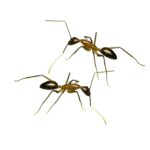



Myrmecocystus Mimicus (Honey Pot Ant)
90,00€ Original price was: 90,00€.80,00€Current price is: 80,00€.
Myrmecocystus Mimicus ant known as a honeypot ant. This species is distributed between Mexico and part of California. Its ability to produce honey and its importance in the balance of the ecosystem within the anthill make it a unique acquisition. Don’t miss the opportunity to have it in your collection! 🐜🍯
- Only queen ant is sent
Sold out
Receive in-stock notifications for this product
Scientific name: Myrmecocystus mimicus
Common name: Honey Ant
Description: Myrmecocystus mimicus is a species of ant belonging to the genus Myrmecocystus. It is characterized by its ability to store and produce honey from nectar secretions. They are medium-sized ants, with a body length ranging from 4 to 7 millimeters. They typically have a predominantly brown or black coloration on their bodies, with some variations in color depending on the geographical region.
Distribution: This species is primarily found in arid and semi-arid regions of North America, including areas of the southwestern United States and Mexico. It inhabits desert habitats, where it constructs its colonies in the ground, often under stones or in areas with sparse vegetation.
Habitat and Behavior: Honey ants are known for their adaptation to arid environments and their ability to store nectar in the abdomen of certain specialized workers called “repletes.” These replete workers can inflate their abdomen to a considerable size, becoming living reservoirs of honey that are fed by other workers. This stored honey serves as a food source during periods of scarcity.
Colonies of Myrmecocystus mimicus are usually subterranean and can reach considerable size, with multiple chambers and interconnected tunnels.
Diet: The diet of honey ants primarily consists of nectar and other sugary liquids collected from plants. Additionally, they may also feed on dead insects and other resources available in their environment.
Reproduction: Reproduction in colonies of Myrmecocystus mimicus is handled by the queens, which produce fertilized and unfertilized eggs. Workers are responsible for caring for the larvae, collecting food, and defending the nest.
Interaction with other organisms: These ants play an important role in desert ecosystems, contributing to seed dispersal and participating in the decomposition of organic matter. Additionally, they are prey for a variety of predators, including birds, reptiles, and other insects.
Related products
Polyrhachis armata
Sold out
Oecophylla smaragdina
Sold out
Camponotus herculeanus
Sold out
Camponotus vanispinus
Sold out
Camponotus maculatus Queen
Sold out
Camponotus nicobarensis
Sold out
Camponotus pseudoirritans
Sold out






















